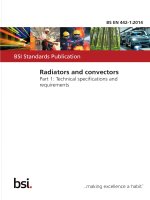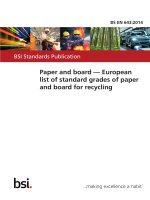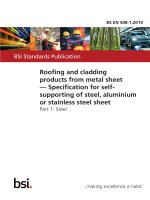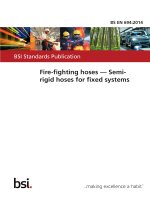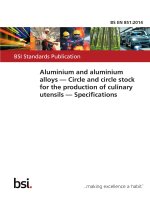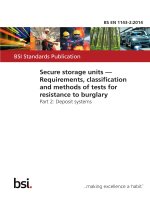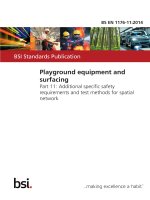Bsi bs en 12268 2014
Bạn đang xem bản rút gọn của tài liệu. Xem và tải ngay bản đầy đủ của tài liệu tại đây (1.35 MB, 46 trang )
BS EN 12268:2014
BSI Standards Publication
Food processing machinery —
Band saw machines — Safety
and hygiene requirements
BS EN 12268:2014
BRITISH STANDARD
National foreword
This British Standard is the UK implementation of EN 12268:2014. It
supersedes BS EN 12268:2003+A1:2010 which is withdrawn.
The UK participation in its preparation was entrusted to Technical
Committee MCE/3/5, Food industry machines.
A list of organizations represented on this committee can be
obtained on request to its secretary.
This publication does not purport to include all the necessary
provisions of a contract. Users are responsible for its correct
application.
© The British Standards Institution 2014. Published by BSI Standards
Limited 2014
ISBN 978 0 580 78340 1
ICS 67.260
Compliance with a British Standard cannot confer immunity from
legal obligations.
This British Standard was published under the authority of the
Standards Policy and Strategy Committee on 30 November 2014.
Amendments issued since publication
Date
Text affected
BS EN 12268:2014
EN 12268
EUROPEAN STANDARD
NORME EUROPÉENNE
EUROPÄISCHE NORM
November 2014
ICS 67.260
Supersedes EN 12268:2003+A1:2010
English Version
Food processing machinery - Band saw machines - Safety and
hygiene requirements
Machines pour les produits alimentaires - Scies à ruban Prescriptions relatives à la sécurité et à l'hygiéne
Nahrungsmittelmaschinen - Bandsägemaschinen Sicherheits- und Hygieneanforderungen
This European Standard was approved by CEN on 13 September 2014.
CEN members are bound to comply with the CEN/CENELEC Internal Regulations which stipulate the conditions for giving this European
Standard the status of a national standard without any alteration. Up-to-date lists and bibliographical references concerning such national
standards may be obtained on application to the CEN-CENELEC Management Centre or to any CEN member.
This European Standard exists in three official versions (English, French, German). A version in any other language made by translation
under the responsibility of a CEN member into its own language and notified to the CEN-CENELEC Management Centre has the same
status as the official versions.
CEN members are the national standards bodies of Austria, Belgium, Bulgaria, Croatia, Cyprus, Czech Republic, Denmark, Estonia,
Finland, Former Yugoslav Republic of Macedonia, France, Germany, Greece, Hungary, Iceland, Ireland, Italy, Latvia, Lithuania,
Luxembourg, Malta, Netherlands, Norway, Poland, Portugal, Romania, Slovakia, Slovenia, Spain, Sweden, Switzerland, Turkey and United
Kingdom.
EUROPEAN COMMITTEE FOR STANDARDIZATION
COMITÉ EUROPÉEN DE NORMALISATION
EUROPÄISCHES KOMITEE FÜR NORMUNG
CEN-CENELEC Management Centre: Avenue Marnix 17, B-1000 Brussels
© 2014 CEN
All rights of exploitation in any form and by any means reserved
worldwide for CEN national Members.
Ref. No. EN 12268:2014 E
BS EN 12268:2014
EN 12268:2014 (E)
Contents
Page
Foreword ..............................................................................................................................................................4
Introduction .........................................................................................................................................................5
1
1.1
1.2
1.2.1
1.2.2
1.2.3
1.2.4
1.2.5
Scope ......................................................................................................................................................6
General ....................................................................................................................................................6
Description of various machine types .................................................................................................6
General ....................................................................................................................................................6
Type A .....................................................................................................................................................7
Type B .....................................................................................................................................................7
Type C .....................................................................................................................................................7
Type D .....................................................................................................................................................8
2
Normative references ............................................................................................................................9
3
Terms and definitions ...........................................................................................................................9
4
List of hazards..................................................................................................................................... 11
5
5.1
5.2
5.2.1
5.2.2
5.2.3
5.2.4
5.2.5
5.2.6
5.3
5.3.1
5.3.2
5.3.3
5.3.4
5.3.5
5.3.6
5.4
5.5
5.6
5.7
5.7.1
5.7.2
5.7.3
5.7.4
5.7.5
5.7.6
Safety requirements and/or measures ............................................................................................. 12
General ................................................................................................................................................. 12
Mechanical hazards ............................................................................................................................ 13
General ................................................................................................................................................. 13
Saw blade protection outside of the cutting zone – Zone 1 ........................................................... 13
Protection at the cutting zone – Zone 2............................................................................................ 13
Bottom and top wheels – Zone 3 and Zone 4 .................................................................................. 17
Sliding feed table – Zone 5 ................................................................................................................ 17
Drive system – Zone 6 ........................................................................................................................ 17
Electrical hazards ............................................................................................................................... 17
General ................................................................................................................................................. 17
Stopping function of switching devices ........................................................................................... 17
Protection against water ingress ...................................................................................................... 17
ON- and OFF-switch ........................................................................................................................... 19
Safety requirements related to electromagnetic phenomena ........................................................ 19
Wheel-mounted band saw machines ................................................................................................ 19
Hazard from loss of stability.............................................................................................................. 19
Noise hazard – Noise reduction at the design stage ...................................................................... 19
Ergonomic requirements ................................................................................................................... 20
Hygiene and cleaning ......................................................................................................................... 20
General ................................................................................................................................................. 20
Food area ............................................................................................................................................. 20
Splash area .......................................................................................................................................... 21
Non-food area...................................................................................................................................... 21
Surface conditions.............................................................................................................................. 21
Cleaning ............................................................................................................................................... 21
6
Verification of safety requirements and/or measures..................................................................... 21
7
7.1
7.2
7.3
Information for use ............................................................................................................................. 23
General ................................................................................................................................................. 23
Instruction handbook ......................................................................................................................... 23
Marking ................................................................................................................................................ 25
Annex A (normative) Noise test code for band saw machines (grade 2) ................................................... 26
2
BS EN 12268:2014
EN 12268:2014 (E)
A.1
A.2
A.3
A.4
A.5
A.6
A.7
A.8
Emission sound pressure level determination ................................................................................ 26
Sound power level determination ...................................................................................................... 26
Installation and mounting conditions ............................................................................................... 26
Operating conditions .......................................................................................................................... 26
Measurement ....................................................................................................................................... 26
Information to be recorded ................................................................................................................. 27
Information to be reported.................................................................................................................. 27
Declaration and verification of the noise emission values ............................................................. 27
Annex B (normative) Design principles to ensure cleanability of band saw machines ............................ 28
B.1
Definitions ............................................................................................................................................ 28
B.2
Materials of construction .................................................................................................................... 29
B.3
Design ................................................................................................................................................... 29
Annex C (informative) Examples of work aid tools having a protective function ...................................... 34
C.1
General ................................................................................................................................................. 34
C.2
Example of a pusher to saw small parts (chicken legs, wings…) .................................................. 34
C.3
Example of a device for cutting pork knuckles, shoulders and chest bones… ........................... 35
C.4
Example of a device for cutting of feet, long products… ................................................................ 36
C.5
Example of a device for cutting frozen plates .................................................................................. 37
C.6
Example of a pusher that is not an integral part of the machine and that slides in the table
groove ................................................................................................................................................... 38
C.7
Example of a device for slicing parts ................................................................................................ 39
Annex ZA (informative) Relationship between this European Standard and the Essential
Requirements of EU Directive 2006/42/EC ........................................................................................ 40
Bibliography ...................................................................................................................................................... 41
3
BS EN 12268:2014
EN 12268:2014 (E)
Foreword
This document (EN 12268:2014) has been prepared by Technical Committee CEN/TC 153 “Machinery
intended for use with foodstuffs and feed”, the secretariat of which is held by DIN.
This European Standard shall be given the status of a national standard, either by publication of an identical
text or by endorsement, at the latest by May 2015 and conflicting national standards shall be withdrawn at the
latest by May 2015.
Attention is drawn to the possibility that some of the elements of this document may be the subject of patent
rights. CEN [and/or CENELEC] shall not be held responsible for identifying any or all such patent rights.
This document supersedes EN 12268:2003+A1:2010.
This document has been prepared under a mandate given to CEN by the European Commission and the
European Free Trade Association, and supports essential requirements of EU Directive 2006/42/EC.
For relationship with EU Directive 2006/42/EC, see informative Annex ZA, which is an integral part of this
document.
Significant changes:
The significant changes with respect to the previous edition EN 12268:2003+A1:2010 are listed below:
—
Clause 1: clarification of the scope; new clause to describe the machine types; displacement of
requirements in the appropriate clauses;
—
Clause 2: normative references updated;
—
Clause 3: terms partly revised (e.g. fixed feed table); consistent use throughout the standard;
—
Clause 4: new presentation in a table;
—
Clause 5: new 5.2 according to the danger zones; more specific requirements to product pusher,
protective rail and blade guide;
—
Clause 6: verification list updated;
—
Clause 7: completion of 7.2 with all information referred to in Clause 5, now including operator training;
7.3 now contains the marking;
—
annexes: old Annex C “Common hazard” deleted and shifted into appropriate clauses;
—
figures partly renewed.
According to the CEN-CENELEC Internal Regulations, the national standards organizations of the following
countries are bound to implement this European Standard: Austria, Belgium, Bulgaria, Croatia, Cyprus, Czech
Republic, Denmark, Estonia, Finland, Former Yugoslav Republic of Macedonia, France, Germany, Greece,
Hungary, Iceland, Ireland, Italy, Latvia, Lithuania, Luxembourg, Malta, Netherlands, Norway, Poland, Portugal,
Romania, Slovakia, Slovenia, Spain, Sweden, Switzerland, Turkey and the United Kingdom.
4
BS EN 12268:2014
EN 12268:2014 (E)
Introduction
This document is a type C standard as stated in EN ISO 12100.
The machinery concerned and the extent to which hazards, hazardous situations and hazardous events are
covered are indicated in the scope of this document.
When provisions of this type C standard are different from those which are stated in type A or B standards, the
provisions of this type C standard take precedence over the provisions of the other standards, for machines
that have been designed and built according to the provisions of this type C standard.
5
BS EN 12268:2014
EN 12268:2014 (E)
1
Scope
1.1
General
This European Standard specifies requirements for the design and manufacturing of band saw machines as
described in 1.2 (see Figures 1 to 5).
The machines covered by this European Standard are used to cut:
—
bones;
—
fresh or deep frozen meat with or without bones;
—
fresh or deep frozen fish, natural or in fillets;
—
deep frozen block food products;
—
fresh or deep frozen vegetables;
—
other products such as pork fat or similar products.
The band saw machines covered by this European Standard do not include band saw machines for
processing wood and similar materials which are covered by the EN 1807 series.
Band saw machines for domestic use are not included in this European Standard.
This European Standard is not applicable to band saw machines which were manufactured before its date of
publication as EN.
This European Standard deals with all significant hazards, hazardous situations and events relevant to band
saw machines, when they are used as intended and under conditions of misuse which are reasonably
foreseeable by the manufacturer (see Clause 4).
This European Standard deals with the hazards which can arise during all the lifetime of the machine,
including the phases of transport, assembly, commissioning, operation, cleaning, use, maintenance,
decommissioning, dismantling, disabling and scrapping of the machine.
This European Standard covers the following types of machines:
—
band saw machines designed as table-top machines with and without base;
—
band saw machines designed as floor-type machines with and without castors.
1.2
1.2.1
Description of various machine types
General
Band saw machines consist of a machine casing, a fixed feed table or a sliding feed table, a roller conveyor or
conveyor belt, a product pusher, a height-adjustable protective rail, a top and a bottom wheel, a saw blade, an
upper and lower blade guide, a blade tensioning device, a drive and electrical components, depending on
machine type. This standard does not deal with machinery with automatic loading/unloading systems
(e.g. automatic conveyors).
6
BS EN 12268:2014
EN 12268:2014 (E)
On floor-type band saw machines, the product to be cut is placed by hand onto the fixed feed table or sliding
feed table and pushed against the cutting zone of the saw blade by means of the product pusher or the rear
table wall on the sliding feed table or by means of the roller conveyor or conveyor belt and sawed.
1.2.2
Type A
Band saw machine with a fixed feed table and a non-detachable, movable product pusher:
Maximum cutting height SH ≤ 250 mm.
Key
Key
1
ON-/OFF-switch
1
ON-/OFF-switch
2
product pusher
2
product pusher
3
portioning plate
3
portioning plate
4
table
4
base
Figure 1 — Band saw machine type A with
product pusher – Location: table top
1.2.3
Figure 2 — Band saw machine type A with
product pusher – Location: base
Type B
Band saw machine with a fixed feed table, a protective rail and a maximum cutting height < 420 mm.
1.2.4
Type C
Band saw machine with a sliding feed table, a protective rail and a maximum cutting height ≤ 420 mm.
7
BS EN 12268:2014
EN 12268:2014 (E)
Key
Key
1
ON-/OFF-switch
1
ON-/OFF-switch
2
door
2
door
3
protective rail
3
protective rail
4
fixed feed table
4
finger protection bar
5
machine rack
5
sliding feed table
6
machine rack
Figure 3 — Band saw machine type B with fixed
feed table and protective rail
1.2.5
Figure 4 — Band saw machine type C with sliding
feed table and protective rail
Type D
Band saw machine with non-automatic feed and removal unit (e.g. roller conveyor, conveyor belt); maximum
cutting height SH ≤ 550 mm.
Key
1 roller conveyor or transport conveyor
Figure 5 — Band saw machine type D with feed and removal unit
8
BS EN 12268:2014
EN 12268:2014 (E)
2
Normative references
The following documents, in whole or in part, are normatively referenced in this document and are
indispensable for its application. For dated references, only the edition cited applies. For undated references,
the latest edition of the referenced document (including any amendments) applies.
EN 614-1, Safety of machinery — Ergonomic design principles — Part 1: Terminology and general principles
EN 1005-1, Safety of machinery — Human physical performance — Part 1: Terms and definitions
EN 1005-2, Safety of machinery — Human physical performance — Part 2: Manual handling of machinery
and component parts of machinery
EN 1005-3, Safety of machinery — Human physical performance — Part 3: Recommended force limits for
machinery operation
EN 1672-2:2005+A1:2009, Food processing machinery — Basic concepts — Part 2: Hygiene requirements
EN 60204-1:2006, Safety of machinery — Electrical equipment of machines — Part 1: General requirements
(IEC 60204-1:2005, modified)
EN 60529, Degrees of protection provided by enclosures (IP Code) (IEC 60529)
EN ISO 3744, Acoustics — Determination of sound power levels and sound energy levels of noise sources
using sound pressure — Engineering methods for an essentially free field over a reflecting plane (ISO 3744)
EN ISO 4871, Acoustics — Declaration and verification of noise emission values of machinery and equipment
(ISO 4871)
EN ISO 11204:2010, Acoustics — Noise emitted by machinery and equipment — Determination of emission
sound pressure levels at a work station and at other specified positions applying accurate environmental
corrections (ISO 11204:2010)
EN ISO 11688-1, Acoustics — Recommended practice for the design of low-noise machinery and equipment
— Part 1: Planning (ISO/TR 11688-1)
EN ISO 12100:2010, Safety of machinery — General principles for design — Risk assessment and risk
reduction (ISO 12100:2010)
EN ISO 13849-1:2008, Safety of machinery — Safety-related parts of control systems — Part 1: General
principles for design (ISO 13849-1:2006)
EN ISO 14119:2013, Safety of machinery — Interlocking devices associated with guards — Principles for
design and selection (ISO 14119:2013)
3
Terms and definitions
For the purposes of this document, the terms and definitions given in EN ISO 12100:2010 and the following
apply.
3.1
portioning plate
plate parallel to the saw blade and adjustable to the required slice thickness
9
BS EN 12268:2014
EN 12268:2014 (E)
3.2
bottom wheel
wheel below the table for driving the saw blade
3.3
blade guide
component for guiding the saw blade
3.4
blade tensioning device
component for tensioning and releasing the tension of a saw blade
3.5
finger protection bar
safeguard on the table rear wall to prevent fingers from reaching the cutting zone
3.6
product pusher
movable device for manually pushing the product towards the cutting zone
3.7
last slice device
plate for feeding the last part of the product
3.8
saw blade
cutting tool in the form of a continuous toothed band
3.9
protective rail
safeguard for covering the unused portion of the saw blade above the cutting zone
3.10
cutting height
thickness of product that can be processed by the machines
3.11
table rear wall
device on the sliding feed table to hold the product and to push it towards the cutting zone
3.12
top wheel
pulley wheel for reversing the saw blade above the table
3.13
cutting line
system for automatic product processing
3.14
fixed feed table
table surface for manual product supply
3.15
sliding feed table
movable table surface with table rear wall for product supply
10
BS EN 12268:2014
EN 12268:2014 (E)
4
List of hazards
This clause contains all the significant hazards, hazardous situations and events, identified by risk
assessment as significant for this type of machine (see Figure 6) and which require measures to eliminate or
reduce the risk associated with the identified hazards (see Table 1).
Table 1 — List of significant hazards
Hazards,
hazardous
situations and
hazardous events
Location or cause
Clause/subclause
in this European
Standard
Hazards
General
5.1
Mechanical
hazards
General
5.2.1
— crushing;
zone 1: area of saw blade outside the cutting zone
5.2.2
— severing;
zone 2: cutting zone
5.2.3
— shearing;
zone 3 and zone 4: bottom and top wheels
5.2.4
— trapping;
zone 5: sliding feed table
5.2.5
zone 6: drive units
5.2.6
— cutting;
— drawing in
Electrical hazards
electric shock from direct or indirect contact with live
components
external influences on electrical equipment (e.g. cleaning with
water)
5.3
Hazards generated
by loss of stability
the complete machine
5.4
Hazards generated
by noise
machines generate noise that can lead to damage of hearing
5.5
Hazard generated
by neglecting
ergonomic
principles
Hazard generated
by neglecting
hygienic design
principles
unhealthy body posture or excessive physical effort;
inadequate consideration of human hand/arm or foot/leg
anatomy by design of machines;
5.6
no respect of the working area.
e.g. contamination by microbial growth or foreign materials
5.7
11
BS EN 12268:2014
EN 12268:2014 (E)
Key
1
zone 1
2
zone 2
3
zone 3
4
zone 4
5
zone 5
6
zone 6
7
zone 7
Figure 6 — Band saw machine – Danger zones
5
5.1
Safety requirements and/or measures
General
Band-saw machines shall comply with the safety requirements and/or protective measures of this clause.
In addition, they shall be designed according to the principles of EN ISO 12100 for hazards relevant but not
significant, which are not dealt with by this document.
Where the means of reducing the risk is by the physical arrangement or positioning of the installed band-saw
machine, the manufacturer shall include in the Information for use a reference to the reduction means to be
provided, and to any limiting value of the requirement, and, if appropriate, to the means of verification.
The safety related parts of the control system shall present at least a performance level “c” in accordance with
EN ISO 13849-1:2008.
For specific intended use and/or applications some examples for work aid tools with a protective function are
given in Annex C.
12
BS EN 12268:2014
EN 12268:2014 (E)
5.2
Mechanical hazards
5.2.1
General
Saw blades shall be removed periodically. Saw blades are sharp and special measures shall be taken. For
such blades, designers shall provide means of attaching a tool to the blade to avoid hand contact and a box,
or surround guard, to protect against the sharp edges of the blade during handling and transportation.
Explanations on the use of these protective means shall be included in the instructions for use.
The interlocking system for movable guards shall be built inside of the machine housing and shall comply with
EN ISO 14119:2013, 4.2 and Clause 7.
In general band saw machines do not require an emergency stop device. If no emergency stop device is fitted,
the normal OFF-switch shall be easily reachable from the operator position (see Figure 1 and Figure 2) and
shall be protected against unintentional switch-on (e.g. by a protective collar).
Cutting tool handling: cutting tools shall be removed periodically. Cutting tools are sharp and special
measures shall be taken. For such blades, designers shall provide means of attaching a tool to the blade to
avoid hand contact and a box, or surround guard, to protect against the sharp edges of the blade during
handling and transportation. Explanations on the use of these protective means shall be included in the
instructions for use.
Verification: Visual inspection of the machine and its documentation.
5.2.2
Saw blade protection outside of the cutting zone – Zone 1
Access to the saw blade outside the cutting zone shall be prevented. This can be achieved e.g. by the
following measures:
A closed machine casing shall be provided. The doors of the casing and the removable or tiltable feed table
shall be interlocked.
Fixing systems for fixed guards or for demountable parts of the machine casing (i.e. designed as fixed guards)
shall remain attached to the guards or to the machine when the guards are removed.
For requirements relating to the interlocking system of doors and the feeding table, see 5.2.1.
After opening the door or the feed table more than 10 mm, the blade shall come to a standstill as soon as is
possible, but the time taken shall not exceed 4 s.
5.2.3
5.2.3.1
Protection at the cutting zone – Zone 2
Type A
Access to the cutting zone of the saw blade shall be prevented. This can be achieved e.g. by the following
measures:
A non-detachable, movable product pusher shall be provided. The product pusher shall be designed so as to
automatically revert to its protective position by its own weight. Distance A1 between the product pusher and
the non-detachable feed table shall be ≤ 6 mm. Design example, see section A – A, Figure 7.
A horizontal adjustable portioning plate of a height > 60 mm shall be provided. The portioning plate may be
designed to be tiltable and removable.
It shall be possible to change the saw blade without removing the product pusher.
13
BS EN 12268:2014
EN 12268:2014 (E)
In case of having a combination of rail and pusher the requirements of type B shall be considered.
Dimensions in millimetres
Key
1
saw blade
A1
distance between the product pusher in its protective position and the non-detachable feed table
Figure 7 — Schematic design of a product pusher
5.2.3.2
Type B
Access to that portion of the cutting zone of the saw blade which is not used for cutting shall be prevented.
This can be achieved e.g. by the following measures:
A non-detachable blade guide and a height adjustable protective rail shall be provided (see Figures 3, 4
and 8). A maximum distance of 6 mm shall be installed, either between product pusher and table or between
blade guide and table. It shall be self-blocking or capable of being blocked in position. When unblocking the
height adjustable protective rail, an abrupt lowering to < 25 mm shall be avoided. The vertical force needed to
move the guard shall not exceed 20 N ± 2 N.
14
BS EN 12268:2014
EN 12268:2014 (E)
Dimensions in millimetres
Key
1 saw blade
Figure 8 — Schematic design of a protective rail
5.2.3.3
Type C
The sliding feed table shall be provided with a system that ensures the safe handling of the product so that
access to the saw blade is prevented by a table rear wall with a finger protection bar. The height of the table
rear wall shall be > 60 mm, and the finger protection bar shall be > 100 mm high and > 50 mm wide. Tapering
towards the top to 25 mm is admissible. The finger protection bar shall overlap the saw blade in the position of
maximum forward travel of the sliding feed table by > 10 mm (see Figure 9 and Figure 10). The blade shall be
protected on 2 faces and in any case, it shall be possible to adjust the protective rail to a distance ≤ 6 mm
from the table.
15
BS EN 12268:2014
EN 12268:2014 (E)
Dimensions in millimetres
Key
Key
1
saw blade
1
saw blade
2
table rear wall
2
table rear wall
3
finger protection bar (in maximum forward
position)
3
finger protection bar (in maximum forward position)
Figure 9 — Band saw machine type C with
protective rail and sliding feed table
Figure 10 — Schematic design of a finger protection bar
When the sliding feed table is locked or tilted down, it shall be possible to establish a continuous table surface
or this shall be present. In the case of a locked sliding feed table, it shall be possible to tilt down the table rear
wall with the finger protection bar. If the finger protection bar is tilted down, the sliding feed table shall be
prevented from being moved.
A horizontal adjustable portioning plate of a height ≥ 60 mm shall be provided. The portioning plate may be
tiltable and detachable.
A last slice device of a height ≥ 150 mm shall be provided. The last slice device may be provided with spikes
on the side facing the saw blade. The last slice device may be removable.
A removable product pusher may be provided.
5.2.3.4
Type D
For requirements relating to the protective rail, see 5.2.3.2.
A product pusher and a portioning plate are not required.
16
BS EN 12268:2014
EN 12268:2014 (E)
5.2.4
Bottom and top wheels – Zone 3 and Zone 4
Access to spokes and the in-running nips on the bottom and top wheels shall be prevented. This can be
achieved e.g. by the following measures:
A closed machine casing shall be provided, see 5.2.2.
5.2.5
Sliding feed table – Zone 5
The sliding feed table at type C machines shall be designed so as to prevent any jumping out or sliding out
from the slide and guide rails.
A product pusher can be fitted on the machine to help on specific cuts. The product pusher shall not interfere
with the use of the protective rail.
5.2.6
Drive system – Zone 6
Access to the danger points on the drive system shall be prevented. This can be achieved e.g. by the
following measures:
A fixed guard or moveable interlocked guard shall be provided on the drive mechanism.
Fixing systems of fixed guards shall remain attached to these guards or to the machine when the guards are
removed.
Movable guards (e.g. for changing the operating process or for cleaning purposes) shall be interlocked.
For requirements relating to the interlocking systems of guards, see 5.2.1.
5.3
Electrical hazards
5.3.1
General
The electrical equipment shall comply with EN 60204-1.
5.3.2
Stopping function of switching devices
The stop function of switching devices shall be in accordance with Category 0, EN 60204-1:2006, 9.2.2.
5.3.3
Protection against water ingress
5.3.3.1
IP degrees of protection
Electrical operating components shall comply with the following degrees of protection in accordance with
EN 60529:
a)
b)
IP X5
External electrical operating components:
1)
on the machine,
2)
on the control box on the machine,
3)
on the control box located in the process room;
IP X3
Internal electrical operating components:
17
BS EN 12268:2014
EN 12268:2014 (E)
1)
c)
d)
in the machine with enclosed housing with the degree of protection IP X5 and open lower surface.
Protection against direct and indirect impact of a water jet shall be ensured;
IP X2
Internal electrical operating components:
1)
in a machine with completely enclosed housing with the degree of protection IP X5. Protection
against condensate water shall be provided,
2)
in the control box enclosure;
IP X0
1)
5.3.3.2
Internal electrical operating components:
in a machine with completely enclosed housing with the degree of protection IP X5. Protection
against condensate water shall be provided, and the safety of fingers and the back of hand be
ensured.
Hoods
Band saw machines which are intended to be cleaned by means of pressurized water shall include measures
to prevent ingress of water into the external electrical operating components. This can be achieved e.g. by the
following measures:
—
the electrical operating components fitted to the band-saw shall be covered by hoods, and,
—
the Instruction handbook shall include advice to this effect for those operating components to be provided
as part of the installation.
Hoods covering the external operating components may be lifted for actuating ON- and OFF-switches. Hoods
shall not, when closed, restrict the use of the OFF-switch (see Figure 11). When using membrane switches or
similar systems, no hoods are needed if the membrane switch or similar systems are suitable for cleaning with
pressurized water.
Key
1
Off
2
On
3
protection hood (Off)
Figure 11 — ON-/OFF-switch with hood
18
BS EN 12268:2014
EN 12268:2014 (E)
5.3.4
ON- and OFF-switch
On band saw machines, ON- and OFF-switches shall be provided. The switches shall be arranged on the
operator side of machines (see Figure 1 and Figure 3). The ON-switch shall be protected against unintentional
switch-on (e.g. protective collar).
5.3.5
Safety requirements related to electromagnetic phenomena
The machines shall have sufficient immunity from electromagnetic disturbances to enable them to operate
safely as intended and not fail to danger when exposed to the levels and types of disturbances intended by
the manufacturer.
The manufacturer of the machines shall design, install and wire the equipment and sub-assemblies taking into
account the instructions of the suppliers of these sub-assemblies.
5.3.6
Wheel-mounted band saw machines
For wheel-mounted band saw machines, the manufacturer shall specify in the instruction handbook that:
—
the machine shall be switched off and the mains plug pulled before being moved,
—
the electrical supply cable shall not be damaged when the machine is moved, and
—
the machine shall be held firmly at suitable locations e.g. by handles when being moved.
5.4
Hazard from loss of stability
Band saw machines shall be designed not to slip, tilt, or roll over under all foreseeable operating conditions.
Band saw machines for floor mounting may be wheel-mounted.
When floor-type band saw machines are not fixed to the floor, sufficient inherent tilt stability e.g. by the design
of the machine, the position of the centre of gravity (wheels and base position) shall be ensured. Wheelmounted machines shall be equipped with e.g. 2 support rollers (or 2 legs) and 2 pivot castors with locking
devices to prevent turning and rolling.
The manufacturer shall give in the instruction handbook information on mounting e.g. relating to the use of the
locking device and to the surface quality of the floor.
The machine shall not slip, tilt, or roll over when tested in accordance with Clause 6, Table 1, line 5.3.
5.5
Noise hazard – Noise reduction at the design stage
When designing band saw machines for food processing, the information and technical measures to control
noise at source given in EN ISO 11688-1 shall be taken into account.
The most important causes for generation of airborne sound at these machines are
—
vibration of moving parts;
—
air current at saw blade;
—
condition of saw blade.
The success of the applied noise reduction measures is assessed on the basis of the actual noise emission
values (see Clause 6 and Annex A) in relation to other machines of the same family.
19
BS EN 12268:2014
EN 12268:2014 (E)
5.6
Ergonomic requirements
The distance A (see Figures 1, 3 to 5) from the floor to the top surface of the feed table shall be between
800 mm and 1 050 mm.
Attention shall be paid to the ergonomic requirement described in EN ISO 12100:2010, 6.2.8, as well as in
EN 614-1 and EN 1005-1, EN 1005-2 and EN 1005-3. Any information for the user which is relevant for
achieving the ergonomic objectives shall be contained in the instruction handbook.
5.7
Hygiene and cleaning
5.7.1
General
The design of the machine shall be in accordance with EN 1672-2 and with the requirements laid down below
as well as in accordance with Annex B.
Hygiene areas see Figure 12.
Key
food area
splash area
non-food area
Figure 12 — Hygiene areas on band saw machines
5.7.2
Food area
The following components are defined according to EN 1672-2 and regarded as food area (see Figure 12):
—
the saw blade;
—
the protective rail;
—
the fixed feed table and/or sliding feed table (upper surface);
—
the roller conveyor;
—
the product pusher;
—
the last slice device;
20
BS EN 12268:2014
EN 12268:2014 (E)
—
the slice thickness plate;
—
the machine casing, with respect to the path of the saw blade;
—
the bottom and top wheels;
—
the chip pan.
5.7.3
Splash area
The following components are defined according to EN 1672-2 and regarded as splash area:
—
the fixed feed table and/or sliding feed table, lower surface;
—
the machine casing, outside and inside.
5.7.4
Non-food area
The non-food area comprises all other surfaces.
5.7.5
Surface conditions
The surface design shall comply with the requirements of EN 1672-2.
The maximum surface roughness values shall comply with the requirements of Annex B.
5.7.6
Cleaning
All surfaces in the food area shall be easy to clean and disinfect. They shall be designed such that cleaning
liquids can run off freely.
Information shall be included in the Instructions for use on the methods recommended for cleaning surfaces in
the food areas, particularly for protective hoods, the product pusher, and the saw blade. Information shall also
be given on general cleaning methods and the adequate removal of cleaning and disinfecting agents and of
any cleaning materials that are unsuitable.
NOTE
6
Cleaning by pressurized water can contaminate the surroundings.
Verification of safety requirements and/or measures
Verification of the requirements defined in Clause 5 and Clause 7 shall be made by means of inspection,
calculation, or testing. These shall be applied to a machine in a fully commissioned condition but partial
dismantling may be necessary for the purpose of some checks. Such partial dismantling shall not invalidate
the result of the verification. The criteria for acceptance should follow the detailed requirements set out in
Clause 5 and Clause 7 or in this clause.
21
BS EN 12268:2014
EN 12268:2014 (E)
Table 2 — Verification list
Subclause
Testing method
5.2.1
Visual inspection of the machine and its documentation
Visual inspection of interlocking systems on doors of casing and on feed table
Functional test with ON-/OFF-switch
5.2.2
Verification of cutting zone and machine casing
Measurement of dimensions
Measurement of stopping time
Verification of electrical circuit diagram.
5.2.3
Measurement of dimensions
Functional test with protective rail
Functional test with product pusher
Functional test on feed table
Visual inspection
5.2.4
Verification of machine casing
Measurement of dimensions
Measurement of stopping time
5.2.5
Visual inspection of the feed table, protective rail and product pusher
5.2.6
Verification of machine casing
Measurement of dimensions
Measurement of stopping time
5.3
The tests according to EN 60204–1:2006, Clause 18, shall be carried out on each
machine
Functional test with hood
Verification of IP-degrees
Functional test of emc performance, or, examination of documentation concerning use
and application of components and sub- assemblies.
5.4
Calculation or standing test on a plane with an inclination of 10°. The wheels shall be
locked and have an unfavourable wheel position. In this position, there shall be:
- functional test by loading product of the maximum size pushed onto the saw blade;
- visual inspection.
5.5
Noise emission measurement according to Annex A
5.6
By visual inspection and measurement
5.7
Measurement of surface roughness, radii and grooves
Visual inspection especially of welding seams
7.2
22
Verification of data
BS EN 12268:2014
EN 12268:2014 (E)
7
7.1
Information for use
General
The user information shall fulfil the requirements of EN ISO 12100:2010, 6.4. An instruction handbook shall be
provided.
7.2
Instruction handbook
The instruction handbook shall at least contain the following information:
a)
b)
c)
d)
information relating to transport, installation and storage:
1)
of the machine;
2)
of the saw blade;
3)
use of personal protective equipment (see 7.2 d);
4)
adequate space at the location;
5)
adequate light at the location;
information relating to commissioning and dismantling:
1)
mounting and installation conditions, e.g. the surface quality of the floor (see 5.1 and 5.4);
2)
conditions of dismantling and disposing;
information relating to the machine:
1)
description of the machine, guards and safety devices;
2)
description of hazards e.g. at cutting zones which could not be fully eliminated by safety devices, e.g.
hazards at not protected saw-zones, generation of noise;
3)
description of adjustment of cutting thickness on portioning plate;
4)
description of use of sliding feed table and last slice device;
5)
description of use of product pusher and adjustable protective rail, of product size as well as warning
on prohibited use: Sawing is not allowed without using the product pusher;
6)
description of electrical installation (see EN 60204-1:2006, Clause 17) and circuit diagram;
7)
declaration of noise emission values (according to Annex A);
information relating to normal operating conditions:
1)
recommended saw blades and applications for each product (type of blades);
2)
description of the use of operating elements which will effect standstill of the machine and that after
use the OFF-switch shall be switched immediately;
23


